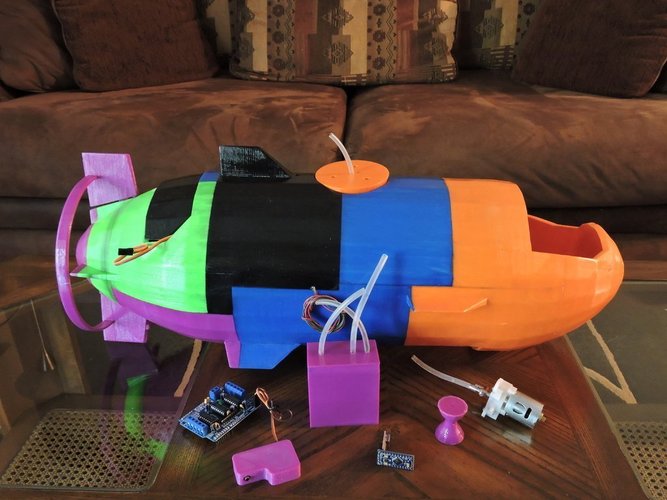
The Catfish - A fully working submarine
pinshape
A fully working submarine, created for the Thingiverse #MakeItFloat challenge, now sits atop a lake bed. The design is a unique twist on an underwater vehicle, with plans to eventually add a fish finder and map the surrounding terrain. Reviews of this ambitious project have been overwhelmingly positive: "a fun, unique design" according to Derek Bower, while omega-00 exclaimed, "this is an incredible build." A 3DPrint.com article delves deeper into the details of this innovative creation. Inspiration for the submarine came from a modified boat design. The initial idea was to create a remote-controlled vessel for use on fishing trips, but it quickly evolved into something more complex and STEM-related. The science behind submarines is fascinating: they can control their buoyancy, allowing them to float or sink at will. This principle, known as Archimedes', states that an object will sink if it weighs more than the water it displaces, while an object will float if it weighs less than the surrounding water. To achieve this level of control, submarines rely on internal ballast tanks. By adjusting the amount of air and water stored in these tanks, a submarine can change its depth. The process involves pumping air into the tank to pressurize it, forcing water out through the bottom, or releasing air from the tank to allow water to enter. But where does this air come from? The answer lies in additional highly pressurized air tanks or CO2 cartridges. However, mixing these with 3D printed parts is not recommended. An alternative solution involves a float/bobber that sits above the water surface, connected to an air tube running down to the submarine's internal air pump. This "float deck" also addresses another issue: wireless communication. Even small amounts of water can disrupt signals, so the float deck keeps the antenna out of the water, maintaining a clear line-of-sight. Alternatively, communication could be limited to when the sub has surfaced, allowing it to complete autonomous missions offline. The submarine itself boasts three pumps, two servos, and one additional DC motor: * The main propulsion pump is a centrifugal design (http://www.thingiverse.com/thing:883212) * A second water pump for priming the first pump is available on Amazon * A diaphragm air pump for surfacing can be found on Amazon as well * Rudder servo controls left/right direction * Air valve servo facilitates depth control (http://www.thingiverse.com/thing:138112) * A DC motor reeling in the float deck is repurposed from a CD-ROM drive Submerging involves opening the air valve to allow water to enter, while closing it when the desired depth is reached. Surfacing requires pumping air into the sub until it has enough buoyancy to return to the surface. Reeling in the float deck can also be done during this process. The air pump must overcome water pressure to push water out, with deeper dives requiring more force. Experimentation will be necessary to determine how deep the submarine can go before the air pump is no longer effective. For detailed instructions on building and operating the submarine, visit the Thingiverse page: http://www.thingiverse.com/thing:920376/#instructions To ensure successful construction, it's essential to calculate the required weight of the parts being printed. Some components are being printed at a density of 30% infill, while others may require more or less material based on their specific needs.
With this file you will be able to print The Catfish - A fully working submarine with your 3D printer. Click on the button and save the file on your computer to work, edit or customize your design. You can also find more 3D designs for printers on The Catfish - A fully working submarine.
